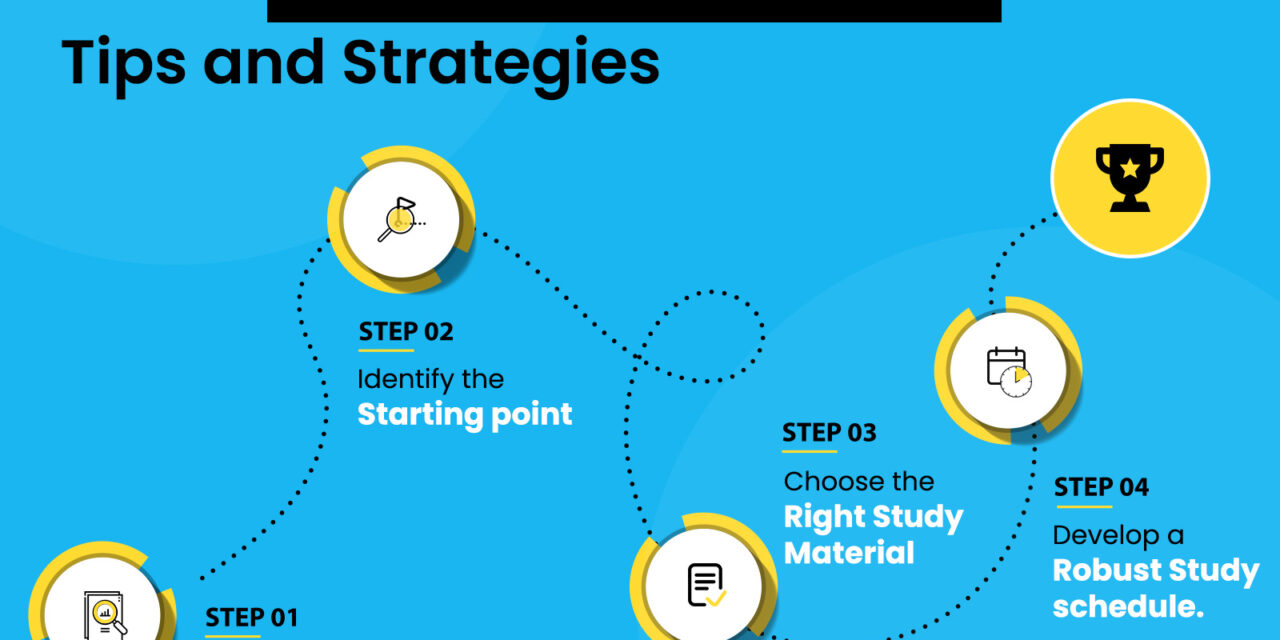Introduction | Executive Assessment Prep
The Executive Assessment (EA) by the Graduate Management Admission Council (GMAC) is an important exam for people looking to boost their careers by getting an MBA or another business-related Master’s degree. It’s specially designed for those applying for Executive MBA programs, testing their problem-solving and reasoning skills, which are crucial in business and career advancement. So, when you’re getting ready for the EA, it’s not just about hitting the books – you also need a well-rounded and thought-out Executive Assessment prep plan.
In this article, we will walk you through the key steps in the Executive Assessment prep. From understanding the test structure, identifying your starting point, and selecting the right study materials, to developing a robust study schedule—we’ll guide you every step of the way. We’ll also provide practical study tips and strategies and a realistic understanding of the time needed for effective preparation.
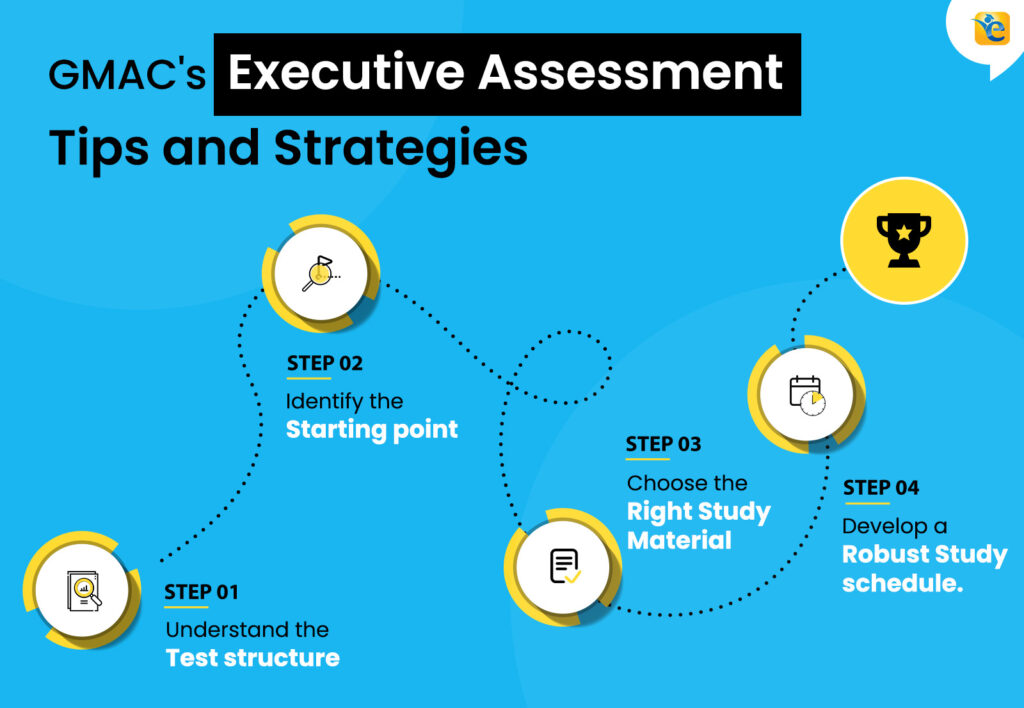
So, whether you are just starting your Executive Assessment prep or looking to fine-tune your approach, this comprehensive guide will provide you with valuable insights and resources. By the end of it, we hope to leave you feeling more confident, better prepared, and thoroughly motivated to conquer the Executive Assessment. After all, the journey to achieving your executive MBA dream starts here!
- Introduction | Executive Assessment Prep
- Understanding the Test Structure
- Identifying Your Starting Point
- Choosing the Right Study Materials
- Developing a Robust Study Schedule | Executive Assessment Prep
- Practical Study Tips and Strategies for Executive Assessment prep
- Understanding the Time Needed for Executive Assessment prep
- Conclusion
Understanding the Test Structure
The first thing you need to do when you start Executive assessment prep is to understand its structure. The test has three main parts – Quantitative Reasoning (Quant), Verbal Reasoning (Verbal), and Integrated Reasoning (IR). Each part plays a role in your total score, which can be anywhere from 100 to 200.
Each of the three sections (Quantitative Reasoning, Verbal Reasoning, and Integrated Reasoning) takes 30 minutes, making the total test duration 90 minutes.
The EA uses an adaptive scoring algorithm that adjusts the difficulty level based on the test-taker’s performance. The scores for each section aren’t directly summed to create the Total Executive Assessment Score; instead, a weighted total is calculated, which ranges from 100 to 200.
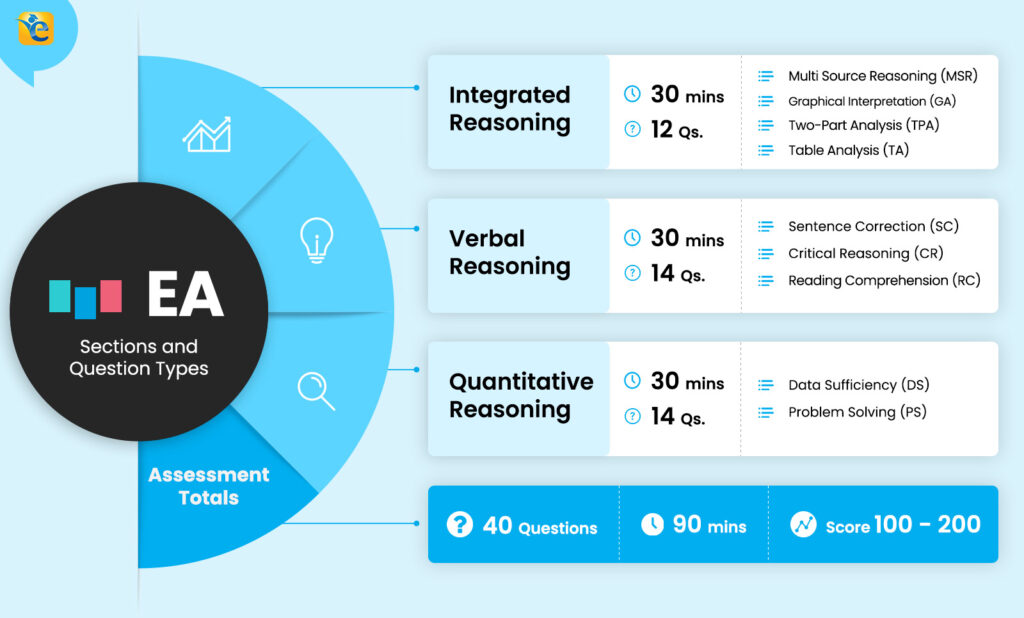
Quantitative Reasoning (QR):
This section measures your ability to analyze data and draw conclusions using mathematical skills. The QR section consists of two subsections:
Problem-Solving:
Tests your ability to use logic and analytical reasoning to solve quantitative problems.
Data Sufficiency:
Tests your ability to analyze a quantitative problem, recognize which data is relevant, and determine at what point there is enough data to solve the problem.
Verbal Reasoning (VR):
This section assesses your ability to read and understand written material, evaluate arguments, and correct written material to conform to standard written English. The VR section is divided into three subsections:
Reading Comprehension:
Tests your ability to understand, analyze, and apply information and concepts in written text.
Critical Reasoning:
Tests your ability to formulate an argument, recognize assumptions, evaluate arguments, and plan to reach a solution. Sentence Correction:
Tests your skills in English written proficiency and the ability to correct sentences to standard written English.
Integrated Reasoning (IR):
This section measures your ability to evaluate information presented in multiple formats from multiple sources. It requires you to use complex reasoning skills to solve problems. The IR section includes four subsections:
Multi-Source Reasoning:
Tests your ability to evaluate data from different sources.
Table Analysis:
Tests your ability to sort and analyze a data table, determining what information is relevant or irrelevant.
Graphics Interpretation:
Tests your ability to interpret and analyze graphical data.
Two-Part Analysis:
Tests your ability to solve complex problems with more than one part .
For comprehensive insights on the comparison between Executive Assessment and GMAT, we invite you to peruse this informative article: Executive Assessment vs. GMAT.
If you are planning to take the GMAT, we can help you with a personalized study plan and give you access to quality online content to prepare. Write to us at support@e-gmat.com. We are the most reviewed GMAT prep company on GMAT club with more than 2400 reviews and are the only prep company that has delivered more than 700+ scores than any other GMAT club partner. Why don’t you take a free trial and judge for yourself?
Identifying Your Starting Point
Before diving into the depth of Executive assessment prep, it is essential to determine your baseline abilities by identifying your strengths and weaknesses. This evaluation will empower you to customize your study plan to focus more intently on improvement areas. Using GMAC’s official practice tests, you can accurately gauge your current performance level, offering a tangible baseline to monitor your progress.
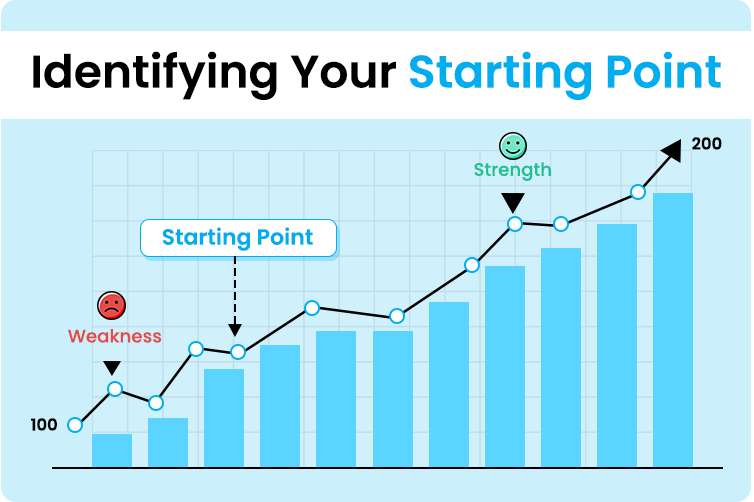
Case Study- Executive Assessment Prep
Robert’s Journey to EA Success
Robert, a senior business consultant with a decade of experience, had his sights set on an EMBA to propel his career forward. Given his busy professional and personal life, a targeted and efficient preparation strategy for the Executive Assessment (EA) was essential.
Establishing a Baseline:
Robert kick-started his EA preparation journey by taking a diagnostic test to identify his starting point. His initial score was 140, a solid start, but quite a bit short of his ambitious target score of 165. This score clearly indicated that he needed to improve in all areas of the exam.
Crafting a Study Plan:
With his baseline score in hand, Robert knew where he stood and how far he had to go. Understanding his strengths and weaknesses was critical, and he used this information to plan his study time effectively.
Given his demanding schedule, Robert dedicated an hour every weekday and three hours each day on weekends to studying. He decided to divide his study time across the three areas of the exam, with a particular focus on the areas where he needed most improvement, based on his baseline performance.
Baseline-Guided Progress:
Throughout his study journey, Robert frequently referred back to his initial score. He regularly took practice tests to monitor his progress, ensuring he was making steady improvements and addressing his weak points. After two months of focused studying, his practice test scores showed significant improvements.
The Outcome:
After four months of rigorous, strategic preparation, Robert sat for the Executive Assessment once again. This time, he achieved his target score of 165, indicating a considerable improvement from his baseline.
Robert’s journey underscores the importance of an initial diagnostic test to establish a baseline score in guiding an EA study plan. By understanding his starting point, Robert could target his efforts effectively, enabling him to efficiently improve his score and successfully reach his EA goal. This strategic approach made it possible for Robert to balance his busy professional and personal life with an intense study schedule, ultimately leading to his success on the EA.
Choosing the Right Study Materials
Your choice of study materials will heavily influence your Executive Assessment prep. The quality and relevance of your study materials directly impact your understanding of the test content, the efficiency of your study time, and, ultimately, your test performance.
There are countless EA study resources available, but not all are created equal. The right materials can streamline your study process, reinforce your understanding of key concepts, and provide you with realistic practice opportunities.
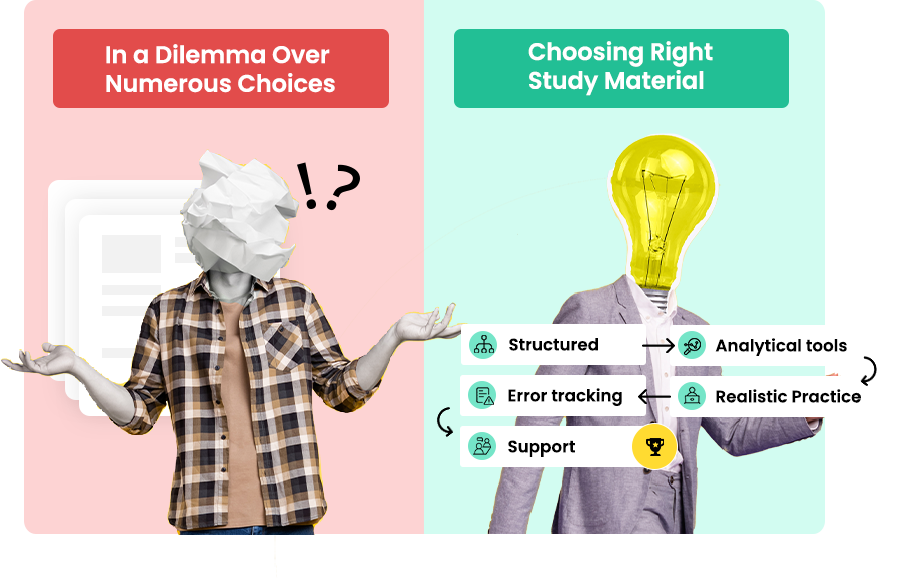
What are the advantages of choosing the Right Study Materials for Executive Assessment prep?
| Advantages of High-Quality EA Study Materials | Drawbacks of Inadequate EA Study Materials | |
| Structure and Relevance | A well-curated study material aligns with the EA structure, ensuring focus on relevant topics. | Inappropriate materials may lead to confusion and wasted time due to their lack of relevance and structured approach. |
| Analytical Tools | Superior study materials offer analytical tools for performance tracking and identifying areas needing improvement. | Materials lacking such tools make progress evaluation challenging, potentially slowing down the learning curve. |
| Error Tracking | Quality materials enable the identification of common errors and offer strategies for avoiding them in the future. | Without this facility, repeated errors could go unnoticed, resulting in point losses on the actual test. |
| Study Plan | Premium resources often include a comprehensive study plan to ensure effective time management and structured learning. | Lack of a structured plan may lead to loss of focus, incomplete topic coverage, or inadequate time for review. |
| Realistic Practice | Excellent study materials provide realistic practice questions resembling those on the actual EA, improving preparedness. | Inferior practice materials may not accurately reflect the EA, resulting in students being unprepared for the test’s format and question style. |
| Support and Doubt clearing | Support and doubt clearing services with high-quality EA study materials facilitate clarification, understanding, and confident progress for students | Without access to reliable sources of assistance, students may find it challenging to clarify their doubts or seek guidance on difficult topics |
Developing a Robust Study Schedule | Executive Assessment Prep
Maintaining a regular study schedule is an absolute prerequisite for success in the Executive Assessment (EA). Your study plan should be personalized to fit your lifestyle, work commitments, and learning pace. Regular practice tests should be incorporated into your schedule, allowing you to gauge your progress and fine-tune your study strategy.
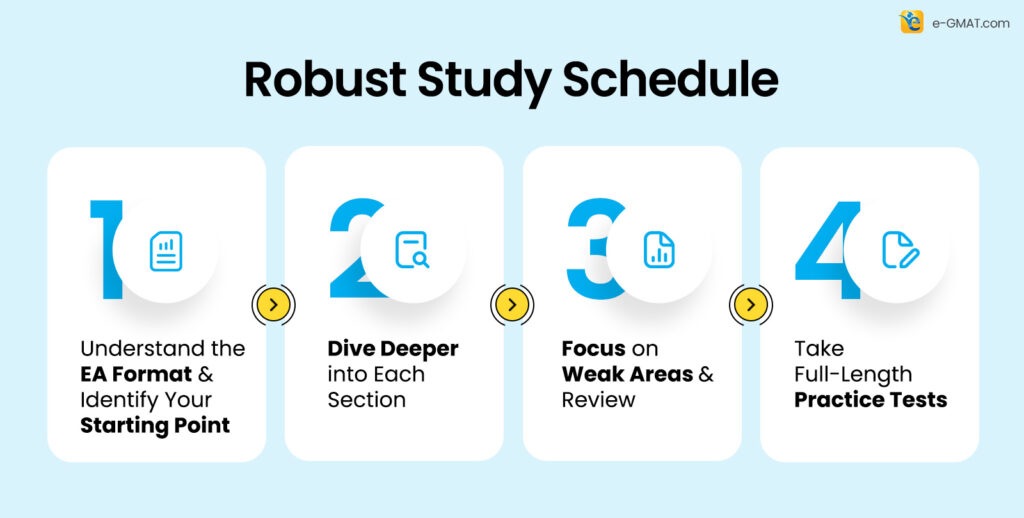
Sample study schedule for the Executive Assessment Prep
Here’s an example of a one-month study schedule, assuming the student can dedicate around 15 hours per week to Executive Assessment prep. It’s important to remember that this schedule should be adjusted based on the individual’s baseline score, target score, and availability.
| Week | Tasks |
| 1 | Understand the EA Format & Identify Your Starting Point • Study the format, scoring, and question types in the EA. • Take a diagnostic test to identify strengths and weaknesses. • Analyze diagnostic test results and identify weak areas. |
| 2 | Dive Deeper into Each Section • Quant: Review basic math concepts and practice problem-solving and data-sufficiency questions. • Verbal: Review the basics of sentence correction, critical reasoning, and reading comprehension. Practice questions. • Integrated Reasoning: Understand the format and practice different question types. |
| 3 | Focus on Weak Areas & Review • Allocate more time to sections where improvement is needed. • Continue to practice questions from all sections • Review difficult questions and learn from mistakes. |
| 4 | Take Full-Length Practice Tests • Take at least two full-length practice tests. • Review and analyze mistakes after each test. • In the last couple of days, relax and review basic concepts. • Avoid learning new concepts or taking a practice test the day before the exam. |
Tips: Remember, consistency is key in preparation. Allocate specific times each day to studying and stick to them. Regular, shorter study sessions are usually more effective than occasional, long ones. This schedule should serve as a general guide and can be adjusted to fit the needs of the individual preparing for the EA.
Practical Study Tips and Strategies for Executive Assessment prep
Employing effective study strategies tailored to the unique requirements of each EA section is paramount.
Quantitative Reasoning:
- Understand Fundamental Concepts: You need to understand the basic concepts and principles of algebra, arithmetic, and statistics. Be comfortable with operations on fractions, powers, and roots, solving equations, and interpreting data.
- Practice Problem-Solving and Data Sufficiency Questions: These are the two main types of questions in this section. Understand their structure and develop strategies to solve them efficiently.
- Time Management: This section requires quick calculations and decision-making. Build your speed through timed practice sessions.
Verbal Reasoning
- Reading Comprehension: Improve your reading speed and comprehension skills. Practice summarizing passages, identifying the main point, and understanding the structure and logic of the arguments.
- Critical Reasoning: Understand argument construction, reasoning concepts, and common reasoning flaws. Practice identifying assumptions, evaluating arguments, and applying logic to answer questions.
- Sentence Correction: Brush up on grammar rules, especially those most commonly tested, like subject-verb agreement, verb tense, parallelism, and pronoun usage.
Integrated Reasoning
- Data Analysis and Interpretation: Practice reading and interpreting data from multiple sources like graphs, tables, and text passages. This section tests your ability to combine information from multiple sources to solve complex problems.
- Multi-Part Analysis: Get comfortable with questions that have multiple parts, where the answer to one aspect may influence the next.
- Two-Part Analysis: Learn to handle questions that require you to select two correct answers.
For each of these sections, high-quality study materials and consistent practice is crucial. A well-balanced study plan with regular practice sessions can significantly boost your confidence and performance on the test. Make sure to take full-length practice tests to build endurance and familiarize yourself with the test-taking experience. Always review your performance after each practice session or test, focusing on understanding your mistakes and areas of weakness.
Regular practice and routine performance review should be a cornerstone of your preparation. Time management, critical for the EA, can be honed through practice tests, helping you efficiently navigate through the different sections of the exam.
Understanding the Time Needed for Executive Assessment prep
The time needed for Executive Assessment prep can vary significantly from person to person and is mainly dependent on three key factors: the individual’s starting point (baseline score), the desired target score, and the amount of time they can dedicate to studying each week.
- Baseline Score: The first step in EA preparation is understanding where you stand. This can be achieved by taking a diagnostic test or an official GMAC practice test. The score you receive gives you a realistic understanding of your strengths and weaknesses and provides a starting point for your preparation.
- Target Score: The higher the score you aim for, the more time you’ll likely need to prepare. If your baseline score is significantly lower than your target score, you’ll need more time to bridge the gap.
- Time Available for Study: The number of hours you can dedicate to studying each week is crucial. A person who can dedicate 20 hours a week to studying will prepare faster than someone who can only dedicate 10 hours a week.
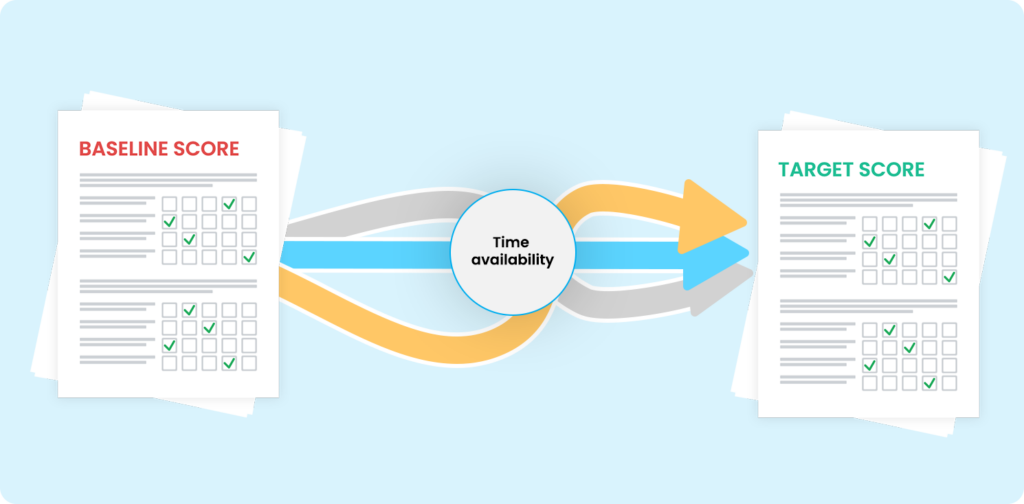
As a general guideline, if your baseline score is close to your target score (within 20-30 points), you may require 1-2 months of dedicated study. If the gap is larger (more than 50 points), you may need 3-4 months or more. It’s essential to maintain consistency during this period, studying regularly each week.
Tips: don’t forget to leave time for full-length practice tests in your preparation schedule. These tests are crucial for building stamina and familiarizing yourself with the exam conditions. They also help you identify areas needing further improvement as you get closer to your exam date.
Conclusion
In conclusion, preparing for the Executive Assessment is an enriching and transformational journey. It requires strategic planning, dedicated effort, and consistent learning. Always remember that your success in this exam is not just a reflection of your cognitive skills, but also of your perseverance, patience, and dedication.
A solid understanding of the EA’s structure, along with a customized study plan that fits your lifestyle and strengthens your weak areas, is pivotal for your success. Ensuring the right study materials is crucial for effective and efficient learning.
Lastly, remember to take sufficient time to prepare. The journey to a high score on the EA is more of a marathon than a sprint. It’s not about how quickly you can complete the race but about how well you pace yourself to cross the finish line confidently.
Remember, as Walt Disney once said, “All our dreams can come true if we have the courage to pursue them.” This is your dream, your journey. Stay the course, and you’ll reap the rewards of your hard work and determination.


